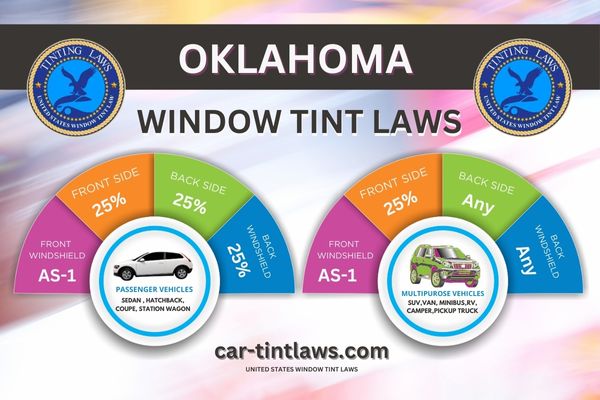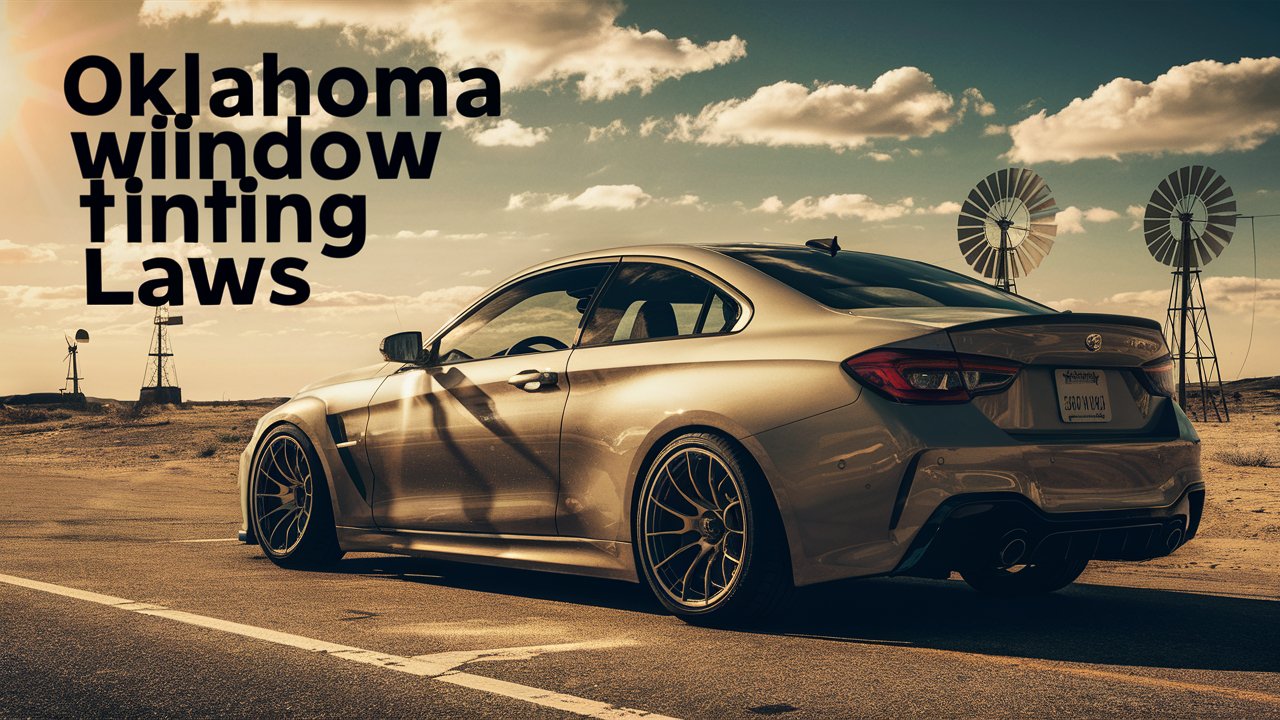Did you know that Oklahoma requires more than 25% light transmission for all windows on sedans?
This intriguing aspect of the state’s window tinting laws sets it apart from other states with differing requirements for SUVs and sedans.
You’ll find the regulations around tint reflection and the necessity for certification from film manufacturers equally significant.
Plus, there’s a fascinating aspect regarding medical exemptions that you might not anticipate.
These rules aren’t just about aesthetics; they’re vital for safety and legal compliance.
What happens if you don’t follow these laws? Let’s explore further.
Window Tint Darkness in Oklahoma
When it comes to tint darkness in Oklahoma, you’ll need to know the specific requirements for different types of vehicles.
For sedans, the law mandates that front side windows, back side windows, and the rear window must allow at least 25% light transmission.
However, SUVs and vans have more lenient rules for back side windows and rear windows, as there are no specific darkness restrictions for these areas.
Tint darkness for sedans:
In Oklahoma, the legal tint darkness for sedan windows is as follows:
- Front Side windows: Must allow more than 25% of light in.
- Back Side windows: Must allow more than 25% of light in.
- Rear Window: Must allow more than 25% of light in.
According to Oklahoma Tint Laws, sedans must maintain this 25% tint darkness requirement to avoid penalties and fines. These regulations aim to balance privacy and visibility for sedan drivers, ensuring clear visibility, especially at night or in adverse weather conditions.
Adhering to the 25% tint darkness standard is essential for sedan owners in Oklahoma to prevent citations, fines, and potential vehicle inspections. Any deviation from the 25% tint darkness can result in window tint violations. By complying with these regulations, you contribute to road safety and avoid the hassle of legal consequences. Always ensure your tint meets Oklahoma Tint Laws to enjoy the benefits of tinted windows without risking violations.
Tint darkness for SUV and Vans:
Windshield: Only non-reflective tint is permitted on the top 6 inches of the windshield
Front Side windows: Must allow more than 25% of light in
Back Side windows: Any shade can be used
Rear window: Any shade can be used
Window Tint Reflection in Oklahoma
When it comes to window tint reflection in Oklahoma, you need to be aware of the specific limits for different types of vehicles. For sedans, SUVs, and vans, the law restricts the reflectivity of window tint to no more than 25% for both front side windows and back side windows. It’s important to follow these guidelines to avoid penalties and guarantee safe driving conditions.
Tint reflection for sedans:
- Front Side windows: Must not be more than 25% reflective.
- Back Side windows: Must not be more than 25% reflective.
- Compliance Importance: Adhering to the 25% reflectivity limit ensures adequate visibility for safe driving.
- Safety Concerns: High reflectivity levels can hinder clear vision, especially at night or in adverse weather conditions.
- Avoiding Distractions: Excessive reflectivity can create distracting reflections for other drivers, potentially causing hazards.
- Legal Consequences: Non-compliance with reflectivity restrictions can lead to legal repercussions.
- Balancing Comfort and Safety: Oklahoma’s laws aim to balance the comfort benefits of tinted windows with the necessity of clear visibility.
- Community Safety: Following these guidelines contributes to a safer driving environment for all road users.
Tint reflection for SUV and vans:
- Front Side windows: Must not be more than 25% reflective.
- Back Side windows: Must not be more than 25% reflective.
- Rear windows: Must not be more than 25% reflective.
Other Oklahoma window tint rules and regulations
- Side Mirrors: No restrictions.
- Restricted Colors: In Oklahoma, all tint colors are permitted.
- Certificates: Manufacturers of film need to certify the film they sell in the state. Ask your dealer if they are using certified film.
- Stickers: The sticker/label of compliance to identify legal tinting is required between the film & glass on each tinted window.
- Medical Exceptions: Oklahoma permits medical exemptions for special tint. For more details about the specific terms of the exemption, consult OK state law.
- Penalties: If pulled over for a window tint violation in Oklahoma, fines may be imposed. The fine may also require you to repair your tint to meet state regulations.

Medical Exemptions for Window Tint Rules in Oklahoma
Traversing Oklahoma’s medical exemptions for window tint rules requires obtaining proper documentation from the Department of Public Safety.
If you have a specific medical condition, you can apply for medical exemptions that allow for darker tints on your vehicle windows.
These exemptions are designed to provide increased privacy and UV protection, which can be vital for individuals with certain health issues.
To qualify, you must secure appropriate documentation, which includes a physician’s statement detailing your medical condition and the necessity for darker window tints.
This documentation must then be submitted to the Department of Public Safety for approval.
Once approved, you’ll receive authorization to install darker tints, but be aware that there are conditions to follow to ensure compliance.
It’s important to adhere to these guidelines, not only to avoid penalties but also to maintain safety on the road.
The specific conditions and restrictions for medical exemptions will be detailed in your approval documentation, and it’s important to follow them closely.
By doing so, you can enjoy the benefits of darker tints while staying within the legal boundaries set by Oklahoma’s window tint rules.
Oklahoma Window Tint Ticket Cost
Frequently, receiving a window tint ticket in Oklahoma can lead to fines ranging from $20 to $100 for the first offense.
Understanding Oklahoma window tint laws is important to avoid these fines and legal issues.
Usually, the initial window tint violation is issued as a fix-it ticket. This means you’ll need to remove or adjust the illegal tint to meet the legal requirements.
If you don’t address the fix-it ticket promptly, subsequent window tint violations can result in increased fines and additional court costs.
Repeat offenses for illegal window tinting can become particularly costly in Oklahoma, making it essential to comply with the state’s regulations.
These fines and legal issues not only hit your wallet but also cause unnecessary stress.
To avoid these complications, it’s important to familiarize yourself with Oklahoma window tint laws before applying any tint to your vehicle’s windows.
Being proactive can save you time, money, and headaches in the long run. Taking the necessary steps to make sure your window tint complies with the law will help you avoid tickets, fines, and other legal issues.
Remember, staying informed and compliant is the best way to keep your vehicle—and your finances—in good standing.
Oklahoma Traffic Law Overview
To guarantee you’re fully aware of Oklahoma’s traffic laws, it’s important to cover several key areas.
These include speed limits, which vary depending on the type of road and location, seat belt requirements for all passengers, and strict DUI regulations to promote road safety.
Understanding these laws is essential for all drivers to avoid penalties and promote safe driving practices.
Speed Limits Overview
While driving through Oklahoma, you’ll encounter various speed limits depending on the type of road and area you’re in.
On rural interstates, the maximum speed limit is 75 mph, allowing you to cover long distances efficiently.
However, when you shift to urban interstates, the speed limit decreases slightly to 70 mph due to increased traffic and safety concerns.
In residential areas, speed limits are typically set between 25-35 mph to guarantee the safety of pedestrians and local residents.
School zones have even more stringent restrictions, with speed limits reduced to 25 mph to protect children.
It’s essential to adhere to these limits to avoid penalties, which can include fines, license points, and even possible license suspension.
Speed limits are strictly enforced by law enforcement, and understanding these regulations is vital for safe and lawful driving.
Just like Oklahoma’s window tint laws, which dictate the Visible Light Transmission (VLT) percentages for side windows, speed limits are designed to keep everyone safe on the road.
There are no exemptions from these speed limits, so always stay vigilant and comply with posted signs to guarantee a smooth and trouble-free driving experience in Oklahoma.
Seat Belt Requirements
Just as important as obeying speed limits, making certain every occupant in your vehicle wears a seat belt is an essential aspect of Oklahoma traffic law.
All drivers and passengers must wear seat belts while the vehicle is in motion. This isn’t just a suggestion; it’s a requirement that helps protect everyone in the event of traffic accidents.
For children under 8 years old or under 4’9′ tall, the law mandates the use of child safety seats.
These specialized restraints are vital for their protection, and it’s your responsibility to make certain they are properly secured.
Failure to adhere to these regulations can result in fines and penalties for both drivers and passengers.
It’s not just about avoiding fines; seat belts save lives. The driver is responsible for ensuring all occupants are safely restrained, whether they are in the front or back seats.
By following these rules, you’re contributing to safer roads and a stronger community.
DUI Regulations
Driving under the influence (DUI) in Oklahoma carries serious consequences that you can’t afford to overlook.
Oklahoma law defines DUI as operating a vehicle with a blood alcohol concentration (BAC) of 0.08% or higher.
If you’re caught driving under the influence, especially with violations like illegal window tinting where windows must allow a certain amount of light to pass, you face severe penalties.
For first-time offenders, this can include fines up to $1,000, license suspension, and possible jail time.
Repeat DUI offenses result in even harsher penalties under Oklahoma law.
These can include longer license suspensions, mandatory installation of an ignition interlock device, and potential felony charges.
Oklahoma’s implied consent laws mean that by driving, you automatically consent to BAC testing if suspected of DUI.
Refusal to comply can lead to immediate license suspension.
A DUI conviction can have long-term consequences, such as increased insurance rates, limited employment opportunities, and damage to your personal reputation.
Just as with legal window tinting where the Visible Light Transmission (VLT) must meet specific standards, following DUI regulations is crucial to avoid serious repercussions.
Adhering to both DUI laws and window tinting guidelines guarantees compliance and safety on the road.
References
Frequently Asked Questions
What Is the Darkest Legal Tint in Oklahoma?
You’re wondering about the darkest legal tint in Oklahoma? For front side windows, back side windows, and the rear window, it’s 25% VLT.
Make sure your car tint meets these restrictions to avoid tint removal or fines.
Can You Get Pulled Over for Tint in Oklahoma?
You can absolutely get pulled over for tint visibility issues in Oklahoma!
During a tint inspection, you’ll face tint fines, and possibly have to deal with tint removal.
Adhering to tint regulations is essential to avoid penalties.
How Much Is a Tint Ticket in Oklahoma?
A tint ticket in Oklahoma costs $20-$100, depending on your violation.
Make sure your tint percentage meets legal limits to avoid fines.
If you get ticketed, follow the tint removal process and consider tint shop recommendations for compliant tint film.
How to Get a Window Tint Exemption in Oklahoma?
To get a window tint exemption, submit medical conditions documentation required for the exemption process.
If approved, apply legal window tint based on approved tint levels. Keep proof for police discretion and expect annual inspections, even for out-of-state vehicles.
Conclusion
Understanding Oklahoma’s window tinting laws is essential for staying on the correct side of the law.
Sedans need more than 25% light transmission for all windows, while SUVs have more flexibility with their rear and back side windows.
Reflectivity should not surpass 25% for any vehicle. Make sure your tint film is certified, display compliance stickers, and keep in mind that medical exemptions need proper documentation.
Don’t learn through experience—adhere to these regulations to evade fines.
